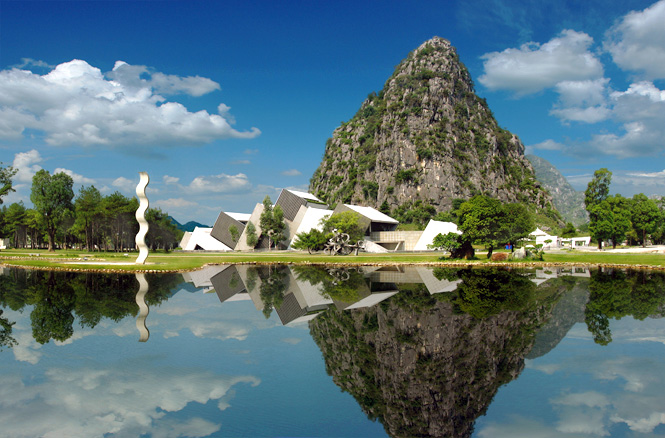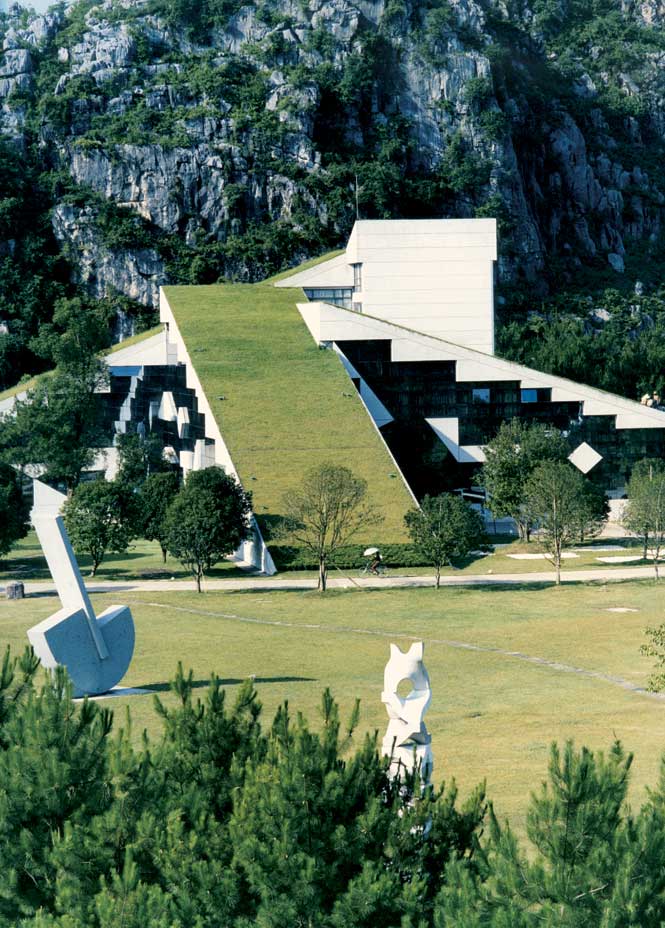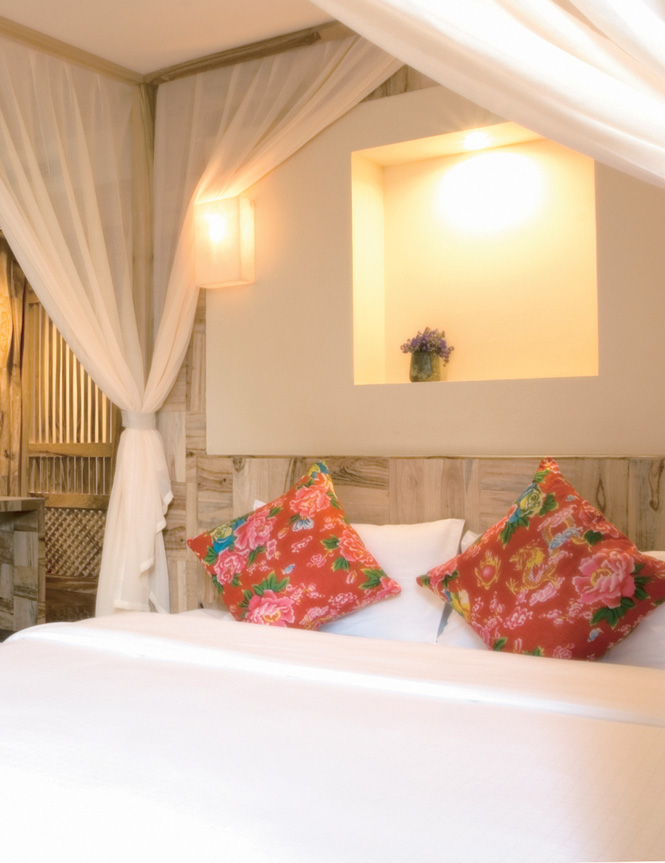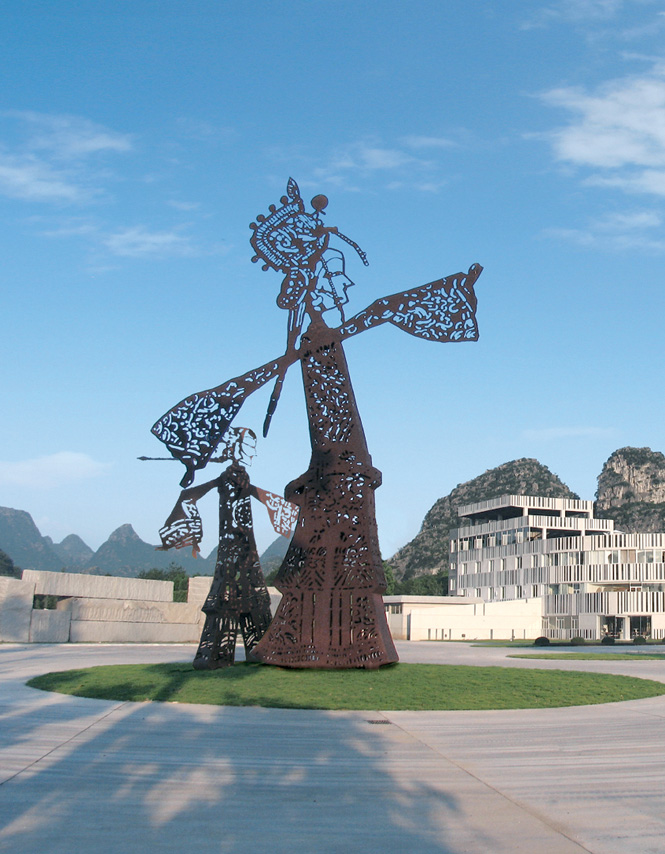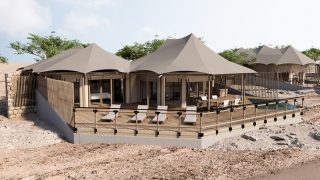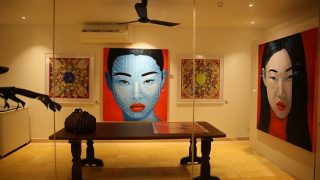In China’s scenic Guilin region, one man’s quixotic vision links nature, art, and comfort
By Daphne Tan
Photographs by Galilea Nin
Like most people, when Ian Rowen first chanced upon Yuzi Paradise, he was startled. “I felt like I wasn’t in China, because I didn’t know a place like this could exist. It definitely wasn’t conventional in any sense,” he says. “Yet there was a certain quality to the people which made me feel at home.” So drawn was Rowen to the place that, little more than a year after his first visit in 2006, he left his Beijing-based job as a luxury tour guide and signed on as marketing manager for the surreal sculpture park and its hotels. “My first day on the job involved showing a European prince and princess around our private villa, the Dream Palace, which they had rented,” he recalls. “The next day, I had to bring Natalie Portman around the hotel.”
Yuzi Paradise lies midway between the cities of Guilin and Yangshuo, spread over 534 hectares that are dotted with fairy-tale limestone peaks, like a Chinese scroll painting come to life. The brainchild of Taiwanese magnate Tsao Rhy-Chang, the property houses one of the world’s largest modern-art parks, along with two hotels, numerous restaurants, spa facilities, an international arts center, the 12-room Dream Palace, and a high-tech greenhouse. There’s also an interactive sculpture area designed for children.
A maverick in every sense of the word, Tsao has been likened to a Taiwanese Don Quixote. He made his fortune constructing one of Taiwan’s largest and most beautiful cemeteries, the Chin Pao San, which is renowned for its tranquil landscaping and striking sculptures. Establishing a modern-art park in the middle of China was a natural next step, at least in Tsao’s view. He explains, “My cemetery has created a new space for people to enjoy the afterlife. Yuzi Paradise is meant for people in this lifetime.”
Work on Tsao’s vision began in 1997 and, while planned as a 30-year project, Yuzi Paradise was opened to the public on April 1, 2003, at a cost of more than US$70 million by today’s exchange rates. The chosen date was no fluke, but a tongue-in-cheek statement echoing the property’s name—yuzi roughly translates as “fool.”
But Yuzi Paradise is no folly. By 2003, it had hosted as many as 11 symposiums featuring world-renowned artists such as Allen Jones, Eberhard Eckerle, Ju Ming, and Barbara Falender. Its symposium program has been on hiatus since then, but art aficionados will still be amply rewarded by a visit: more than 200 large sculpture installations by 140 artists from 47 different countries have been created in the on-site atelier, an airy, hangar-like space with first-rate facilities for sculpture, printmaking, pottery, and glassblowing. The park is home to eye-catching sculptures like Falender’s Between Fire and Water, a tall, unadorned ripple of gray granite that has become one of its signature pieces. When viewed from various vantage points around the property, it either appears as gently undulating, or ramrod straight. Another acclaimed work, Strange Loops by German sculptor Eckerle, consists of large twisted whirls of polished metal. Visitors and hotel guests can also take part in the iArt program, a flexible course led by Yuzi’s resident artists.
Accommodation at the park is equally creative, and sublimely comfortable. The Hotel of Modern Art (HOMA) Libre is an intimate boutique residence set in the middle of the park at the base of a towering limestone outcrop. Featuring four sloping roofs that have been planted over with grass, the striking, ziggurat-like structure was designed by Shiau Jon-jen, Yuzi’s original art director. The hotel’s spacious lobby is bathed in light and neutral hues with walls of locally hewn stone, and its centerpiece is a circular pond ringed by sculptures. None of the 49 guest rooms here are exactly the same, though they all incorporate a mix of Scandinavian design with modern, artistic flourishes. One room, for example, features curving, cave-like walls that seem to be sculpted out of candle wax, while the vibrant HOMA Suite features a sloping ceiling and Taiwanese aboriginal art.
The larger HOMA Sutra, the park’s second hotel, was originally constructed to house employees. According to Rowen, its name was inspired by the Buddhist Heart of Prajna Paramita sutra, whose text has been translated into a series of barcodes and emblazoned across the building’s white exterior, creating a visually arresting effect that recalls piano keys. Inside, camphor and marble sculptures dot the lobby area, while the 118 rooms are no less mesmerizing than those at the HOMA Libre. Twin Pigs, the hotel’s restaurant, is named for Tsao and his son, both of whom were born in the Year of the Pig. Like most of the eateries in Yuzi Paradise, it serves a brand of Chinese-fusion food. Meals here don’t disappoint, but more memorable is a private dinner in one of the property’s many limestone caves, linen-clad tables and sparkling chandeliers included.
Then there’s the Dream Palace, Tsao’s own idiosyncratic villa that is rented out to visiting dignitaries and tycoons for the tidy sum of US$10,000 a night. Inspired by the Guggenheim Museum in Bilbao, Spain, the steel-and-glass residence comes with a private restaurant, boardrooms, a fitness center, a spa, a swimming pool, a karaoke lounge, and 12 remarkable—if occasionally libidinous—bedrooms. All interiors were furnished under Tsao’s direction, with the master bedroom as his pièce de résistance. A surreal labyrinth, the cavernous space features a gilt headboard carved with frolicking nymphs, while large reliefs of the female form in varying shapes and sizes adorn the polished-wood walls. One of the winding passageways will lead you to a faux-outdoor bathroom decorated with numerous twinkling lights to mimic the night sky, while another directs you to a private office. A third corridor ends at a cozy outdoor dining nook, appropriately known as ‘the nest’. Big Dream, a two-story sculpture, symbolizes Tsao’s search for himself as well as his love of camphor wood. It perfumes the air with a tingly menthol scent.
“An Italian art critic once said that while the villa was kitsch, he still appreciated Mr. Tsao’s ambition,” recalls Key Lu, a sales manager who has been with Yuzi Paradise for nine years. “That, and the fact that he dared to express it.”
Yuzi Paradise, Dabu Town, Yanshan District, Guilin; 86-773/386-7888; guilinhoma.com; doubles from US$270
China Chic: Four more hotels that break the mold
Banyan Tree Ringha
Perched 3,000 meters above sea level, this alpine hideaway in northwestern Yunnan offers breathtaking views of snow-capped peaks and a forested river valley from the balconies of its 32 rustic-luxe suites. The buildings—made of packed earth and painted timber—may be relocated Tibetan farmhouses, but here they’re given a luxurious upgrade with hand-knotted carpets, lacquered furnishings, vivid thangkas, and elegant stone hearths that guarantee warmth even when the temperature outside drops below freezing. Bathrooms come with deep-barrel tubs and signature Banyan Tree amenities, including a local moisturizer made from snake essence. The Tibetan chef’s delicious yak burger provides fuel for guided mountain treks or leisurely pony rides around the property, after which you can bliss out with a traditional gui shi massage that employs hot stones carved with holy mantras (Hong Po Village; 86-887/828-8822; banyantree.com; doubles from US$450).
Brilliant Resort & Spa
Set on the shores of picturesque Yangzong Lake is the new gem of Kunming’s lodgings scene. Each of its 21 thatched-roof villas comes with lake views, plunge pools, and private terraces. But perhaps the main draw at this intimate resort is the spa, which boasts 26 outdoor hot-spring pools built from volcanic rocks and fragrant cypress wood, a naturally heated lava-rock sauna, and house-blended massage oils. At the Pu’er Tea Club, guests can sample rare varieties of Yunnan’s famed infusion while taking part in a traditional tea ceremony (Yangzonghai, Kunming, Yunnan; 86-871/ 767-1666; brilliantspa.com; doubles from US$195).
Commune by The Great Wall
Commune debuted six years ago as a cluster of strikingly contemporary holiday villas designed by a dozen of Asia’s top architects. Located 70 kilometers northwest of Beijing in the Badaling Mountains, the complex reopened in 2006 as a Kempinski-managed hotel and now has five-star services and facilities (not to mention an additional 31 villas) to match its aesthetic appeal. A communal clubhouse is home to an art gallery, a terrace restaurant, a small cinema, and an excellent kids’ club, while the adjoining Anantara Spa delivers aromatic honey-and-milk baths and Ayurvedic massages. But the accommodations continue to be the main draw: sleek and calming, most have views of the 400-year-old Shuiguan section of the Great Wall (Yanqing County; 86-10/8118-1888; www.commune.com.cn; doubles from US$282).
Kayumanis Nanjing
The location for this issue’s fashion feature (starting on page 86), this outpost of Bali-based hotel group Kayumanis comprises 21 tile-roofed brick villas, each with lacquered folding doors that open to reveal a flagstoned courtyard, lap pool, and open-air thermal bath filled with water from the hot springs of the nearby Tangshan mountains. Six different decoration styles—including Peranakan, Tibetan, Balinese, and Javanese—give guests a choice of soigné surrounds, while a team of Balinese and Chinese butlers keep things running like clockwork. A resident spa offers treatments and tai chi sessions for those seeking inner harmony, while calligraphy lessons and excursions to historic Nanjing, a Ming-era imperial capital, round out the list of diversions (Sizhuang Village, Tangshan; 86-25/8410-7777; kayumanis.com; doubles from US$499).
Originally appeared in the April 2008 print issue of DestinAsian magazine (“Artful Lodgings”)

